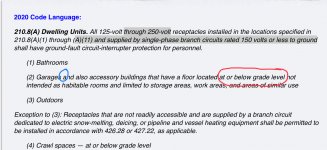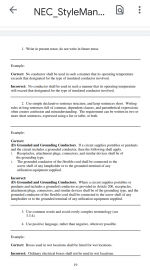
Theoretical questions.
Given: A stand alone accessory building workshop with slab on grade construction. The finished floor is the 6” thick concrete slab.
The top of the slab is 6” above grade, but the bottom of the slab is at grade. Certainly you would expect gfci to be required.
But now to the floor you add panels of 1” polyiso insulation and cover with osb sheets. Now the finish floor is 7” above grade.
Is gfci now required?
Next question…
In 2017 there is a comma after the word garages (blue) and in 2020 the comma is removed.
What does this mean?
Does it mean all garages must have gfci AND all accessory buildings that have a floor that is at or below grade level must have gfci?
Or does it mean that garages that have floors above grade level are also exempt?
I wish they would not include multiple concepts under the same code unless they wanted all the conditions to apply to all the concepts. … But maybe they do.



